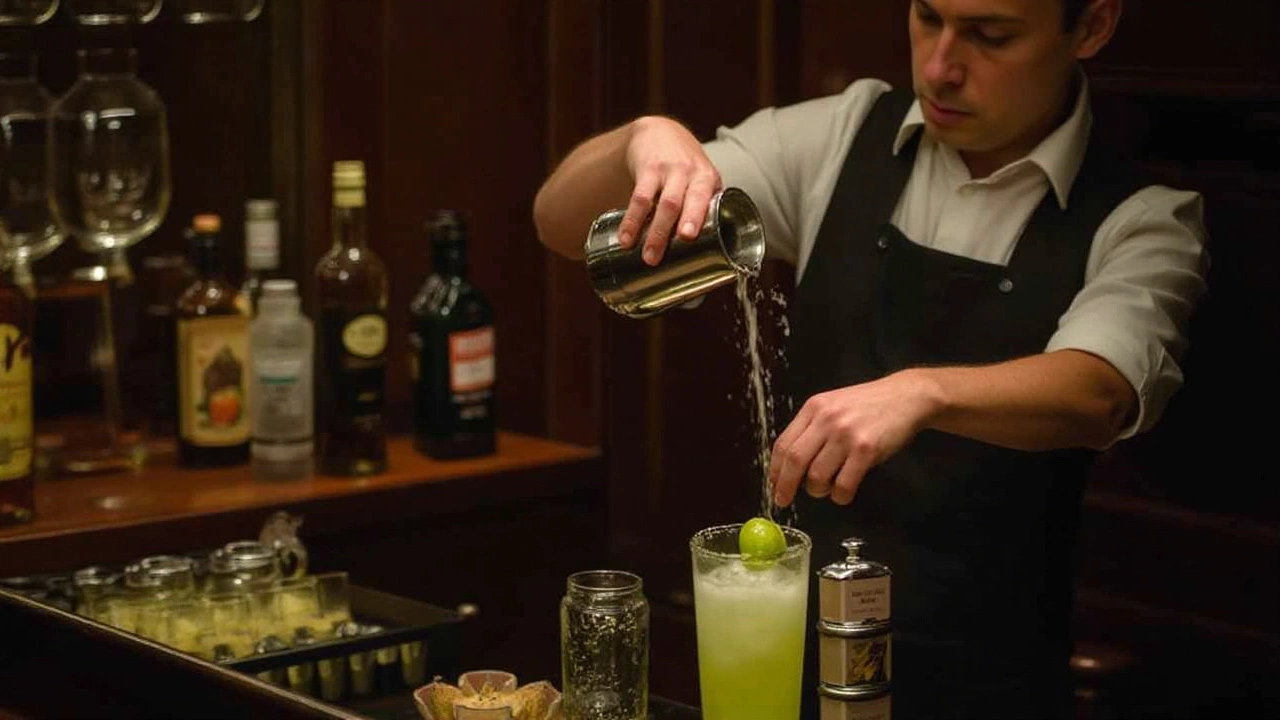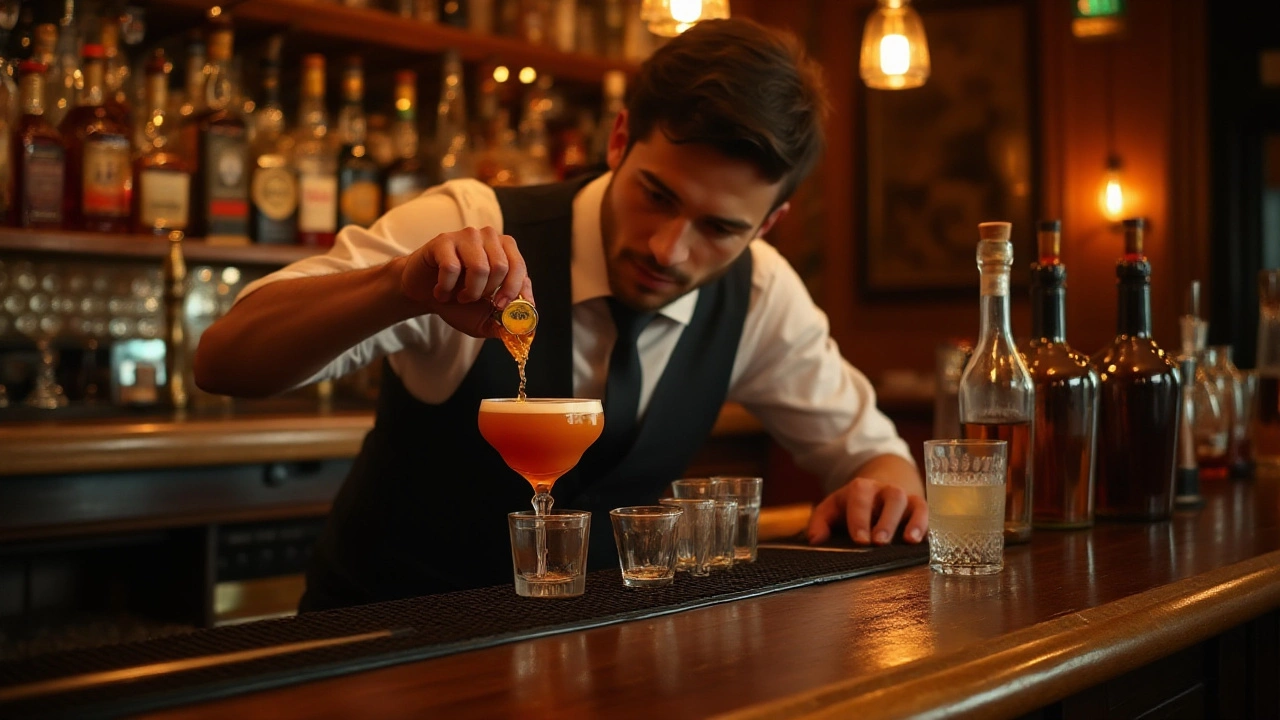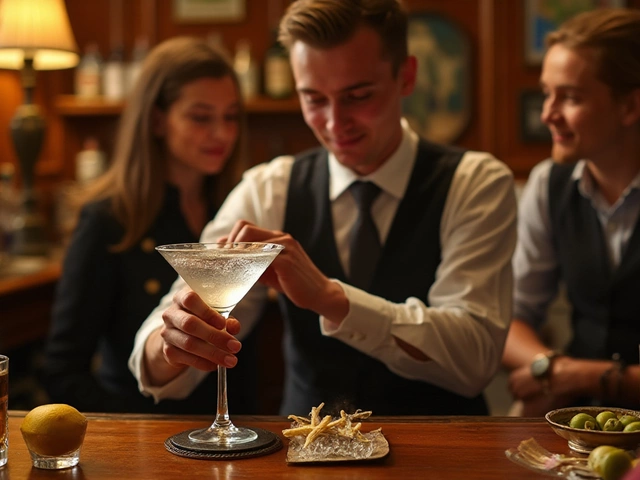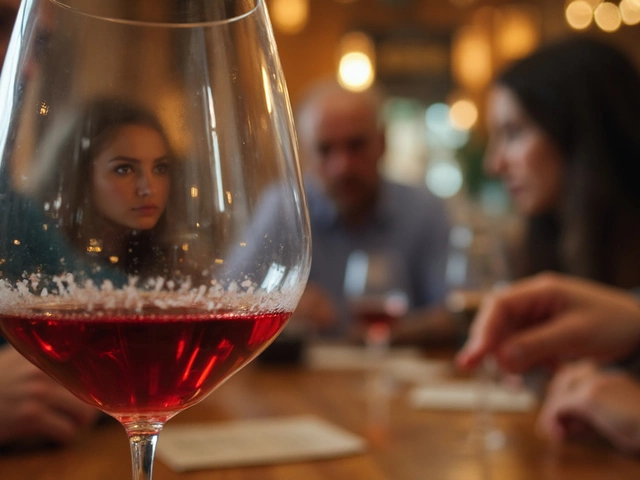Every bartender needs a toolkit of essential cocktails to serve with confidence and style. Recognizing the popular demand for classic drinks, mastering a few key recipes can elevate one's craft and service quality.
The mixology world treasures both old and innovative recipes, but some drinks have earned a permanent place on cocktail menus globally. By learning the backstory and subtle nuances of these iconic beverages, bartenders can deliver a memorable experience for their patrons.
Whether you're standing behind the bar or inviting friends over for dinner, having a solid understanding of these celebrated cocktails ensures you're ready for any request. Dive into the fascinating stories and techniques that transform simple ingredients into a delightful drinking experience.
- The Classic Old Fashioned
- Exploring Margaritas
- The All-Time Favorite Martini
- The Timeless Manhattan
- Refreshing Mojitos
The Classic Old Fashioned
If there is one cocktail that symbolizes the birth of the modern American cocktail, it's the Old Fashioned. With origins tracing back to the early 19th century, this drink was reputedly first conjured at the Pendennis Club in Louisville, Kentucky. The foundation of the Old Fashioned is its simplicity, pairing whiskey with bitters, a sugar cube, and a twist of citrus.
In the Victorian era, the rise of the cocktail culture in the United States meant holding more than just a glass of potent liquor; it meant sipping on a balanced concoction of flavors. The Old Fashioned quickly became a favorite, enduring through decades of cocktail evolution and solidifying its status as a staple among bartenders across the globe. The choice of whiskey can greatly influence the cocktail’s final flavor profile. While traditionally made with bourbon, opting for rye whiskey introduces a spicier character that many aficionados appreciate.
"The Old Fashioned is the only cocktail that has remained in fashion throughout the ages," notes cocktail historian David Wondrich. "It’s a drink that embodies what a cocktail is meant to be."
Creating an Old Fashioned starts with the muddling of a sugar cube and bitters in an Old Fashioned glass. This process is crucial as it blends the sweetness with the bitterness, forming the flavor core of the drink. Following the addition of a large ice cube, whiskey is poured into the mix. The final step involves expressing the oils from an orange or lemon peel over the glass and garnishing with the peel itself. This simple garnish adds a layer of aroma and flavor that's hard to miss.
For those looking to master this eternal classic, a few tips can make a substantial difference. Using a large single piece of ice allows the drink to chill without excessive dilution, ensuring the flavors remain bold and balanced. If you're experimenting with variations, adding a touch of water can soften the overall strength, allowing the blend of ingredients to shine even more clearly.
| Year | Mention |
|---|---|
| 1806 | First use of 'cocktail' in print |
| 1862 | First known recipe in print |
In an age where new cocktails pop up every day, the Old Fashioned remains a beloved constant on cocktail menus. Its ability to deliver strength, sweetness, and depth in one glass reflects an art that’s just as rewarding today as it was over a century ago. For any aspiring or seasoned bartender, mastering this drink is not just about following a recipe—it's about honoring tradition while applying your personal touch.
Exploring Margaritas
The Margarita is a cocktail that carries with it an intriguing history and a bold flavor profile, having garnered a fanbase since its inception. Its origins are contested, with stories ranging from Mexican bartenders to American socialites in the 1930s and 1940s, each claiming to have invented the magic mix of tequila, lime, and triple sec. However, despite these conflicting accounts, what’s unarguably certain is the Margarita's enduring popularity. Often associated with beachside vacations and vibrant gatherings, this drink encapsulates a carefree spirit like no other. When crafting a Margarita, a bartender must balance its foundational triad of ingredients: the earthiness of a quality tequila, the tartness of fresh lime juice, and the sweet citrus notes from an orange liqueur. This trio creates a refreshing dialogue on the palate, capable of delightful twists with the inclusion of fruit purees or infusions.
To refine your mixology skills when preparing Margaritas, attention to detail remains essential. Consider the type of tequila used; while silver or blanco tequilas provide a clean and peppery taste, reposados, aged for two months or more in oak barrels, can offer nuances of mild woodiness and caramel. The lime juice must be freshly squeezed, encouraging a zesty tang rather than the often-flat bottled alternatives. Triple Sec, too, deserves selection care; brands vary greatly in their sweetness and viscosity, affecting the drink’s overall texture. While many purists insist on serving it shaken and strained into a salted-rim glass, presenting the Margarita over ice or even frozen has its devotees. Regardless of serving style, whether you opt to garnish with a slice of lime or add a touch of flair with a fruit wedge, maintaining the Margarita's integral flavors is key.
Cocktail historian David Wondrich once noted, "No two Margaritas are precisely alike; they are as distinct as the personalities of those who craft them." This reflects the personal touch each bartender brings to the concoction, allowing personal and regional preferences to shine through.Beyond its simple recipe, the Margarita's adaptability makes it a favorite all year round. Its flavors offer a blank canvas for creativity, where additions like jalapeños for a spicy kick or a dash of Grand Marnier for added richness can elevate the experience. Other variations like the Cadillac Margarita use high-end ingredients for a luxurious twist, while the flavored versions, such as strawberry or mango, cater to a sweeter palate. A classic Margarita serves as a testament to the balance needed in mixology—a skill that all esteemed bartenders aspire to perfect over time. Mastering these nuances not only pays homage to the art of crafting cocktails but ensures that this beloved drink remains forever timely in its appeal.

The All-Time Favorite Martini
The **Martini** is arguably the most iconic cocktail, embodying simplicity and elegance in a glass. Its origins trace back to the late 19th century, supposedly emerging from the Americano cocktail, which was popular in various European regions. While there are numerous renditions of the martini, purists will insist on its classic form—a harmonious blend of gin and dry vermouth brought together in a coup. Its elegance is often symbolized by a twist of lemon peel or an olive garnish, each offering a subtle transformation in flavor.
This classic concoction stands as a true test of a bartender’s prowess, balancing proportions with precision to cater to one's palate. There is no one-size-fits-all approach to crafting the perfect **Martini**. Fresh ice, top-quality spirits, and the right mixing technique can elevate your cocktail from ordinary to exceptional. Interestingly, the debate on 'shaken vs. stirred'—immortalized by *James Bond*—divides enthusiasts. Icy, smooth, and refreshing, a well-made Martini can complement a variety of occasions and moods. The balance lies in the preparation, where the vermouth's dry zest and gin's botanical depth should feel indulged and forward.
"A well-made Martini is a work of art, a celebration of life's little pleasures," says renowned mixologist Gary Regan.With modern twists and inventive variations, the **Martini** evolves with time. Whether it’s the vodka variation popularized in Hollywood or infused versions with exotic flavors, each presents a new canvas of tasting adventure. However, its timeless charm lies in the original recipe—a testament to its enduring popularity. According to a recent survey, the Martini remains among the top five cocktails ordered at bars worldwide, underscoring its universal appeal. For every newbie in the world of cocktails, the **Martini** symbolizes a rite of passage, mastering the balance of flavors with just a few simple ingredients.
An aspiring bartender or cocktail enthusiast can start with a classic recipe as follows:
- Chill your glass in the freezer or with ice water before use.
- Fill a mixing glass with ice and add 2 ½ ounces of gin.
- Pour in ½ ounce of dry vermouth. Adjust to taste as needed.
- Stir the mixture for about 30 seconds—to achieve an icy texture.
- Strain into the chilled glass.
- Garnish with your choice of a lemon twist or olive—add both for a Gibson!
A masterful **Martini** blends detail with intuition, making it a formidable companion for any drink enthusiast. Its rich history and established place in cocktail culture are testaments to the drink’s prowess, fulfilling a narrative woven from decades of social gatherings, celebrations, and quiet contemplation.
The Timeless Manhattan
When it comes to iconic cocktails that capture the essence of sophistication and history, the Manhattan stands out with its combination of whiskey, sweet vermouth, and bitters. This cocktail has been charming drinkers since the late 19th century, emerging from the bustling streets of New York City. Legend has it that the drink was concocted at the Manhattan Club in the early 1870s, although some sources dispute this vibrant origin story. The mix of ingredients, however, is simple yet harmonious, making it a delightful choice that balances sweetness with strength.
To craft a classic Manhattan, mixologists typically reach for rye whiskey, which complements the richness of the vermouth and the aromatic kick of Angostura bitters. However, bourbon can also serve as a worthy substitute for those who prefer its smoother, sweeter profile. The cocktail is traditionally stirred, not shaken, allowing the ingredients to meld smoothly without diluting their potent flavors. A cherry, preferably the dark French variety, is meticulously placed at the bottom of the glass, adding a touch of elegance and a hint of sweetness that rounds off the drink's bold and memorable profile.
The beauty of the Manhattan lies not just in its flavor profile but also in its adaptability. With lovers of the cocktail scattered worldwide, many bartenders take creative license with the recipe, swapping in different bitters or experimenting with different types of vermouth to cater to diverse palates. This versatility ensures that the drink feels at home in upscale venues and cozy taverns alike, winning the affection of those who appreciate its caramel notes and lingering warmth. The Manhattan remains an enduring symbol of timeless bartending craft and cultural exploration. According to renowned mixologist Dale DeGroff, often dubbed "King Cocktail," "Mixology is not necessarily about inventing, it's also about polishing existing frames and garnishing them with care."
The Manhattan’s cultural impact is undeniable, weaving its way into literature, film, and the living room of any serious cocktail enthusiast. It has become a marker of a bartender’s skill, as the simplicity of its ingredients requires precise execution to achieve the perfect balance. For those who delight in experimenting, adjusting the ratio of whiskey to vermouth, or exploring the use of house-made bitters can personalize the experience further. The options are plentiful, yet the core identity remains familiar, offering both comfort and sophistication in every graceful sip. Whether enjoyed in a dimly lit jazz bar or at a lavish home gathering, the Manhattan continues to be the choice of drinkers who seek both tradition and innovation in their cocktail experiences.

Refreshing Mojitos
The Mojito is a true cocktail staple, renowned for its refreshing taste and timeless appeal, making it a favorite for many bartenders to offer. Originating in Cuba, the Mojito has a rich history intertwined with the vibrant culture of the Caribbean. Ernest Hemingway, a key figure associated with this drink, enjoyed it at La Bodeguita del Medio in Havana, a fact which adds a bit of celebrity flair to its story. To create this outstanding drink, bartenders focus on the balance of five simple ingredients: white rum, sugar, lime juice, soda water, and mint. The magic begins by muddling the mint leaves with sugar and lime to release essential oils and elevate the fresh aroma. Understanding this foundation helps bartenders achieve the perfect harmony between the sweetness, citrus, and herby zing that characterizes a Mojito.
Mojitos are more than just a summer beverage—they're an experience. This cocktail represents the perfect blend of a relaxing afternoon and a vibrant evening, embodied in a glass that invites conversation and joy. When crafting a Mojito, quality matters. Using fresh ingredients, especially mint, transformed from ordinary to extraordinary. Chilled soda water adds the bubbly delight, while the choice of rum can significantly influence the cocktail's overall profile. Some bartenders prefer a light white rum, which subtly mingles with the flavors, while others might experiment with more fragrant varieties, each bringing its own flair to the table. A sprinkle of bitters here, a dash of flavored syrup there, today's Mojitos may even include unexpected twists like fruit infusions or spicy notes.
"Good drinks start with good conversations, and Mojitos have a way of somehow starting both," says renowned mixologist José Andrés, emphasizing the importance of crafting not just a drink, but an experience.
For those looking to introduce a bit of mixology into their lives, Mojitos offer a simple yet satisfying start. The versatility of this cocktail allows bartenders to tailor it to individual tastes. Whether you're a home enthusiast or a professional, experimenting with proportions and presentation is where the real creativity comes to life. Some like it sweeter, others more tart; a Mojito can adapt seamlessly to your palate. Remember, the key lies in careful muddling and the artful layering of flavors, respecting the balance that makes the Mojito sing. A sprig of mint as garnish isn't just decorative—it's part of the whole sensory experience.
Consider the many variations across different regions, which showcase the adaptability of this timeless drink. In some places, bartenders might add ripe strawberries for a fruity twist or even fresh ginger for an added kick. With a bit of experimentation, these regional adaptations keep the Mojito alive and evolving, allowing it to remain a beloved classic across the world. Whether served in a highball or a fancy jar, with extra mint or a splash of dark rum, the Mojito continues to engage and refresh. As you embark on your Mojito journey, remember that each shake and stir adds your signature to this globally adored drink.


